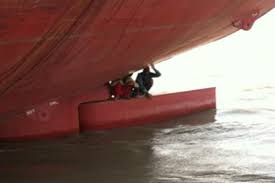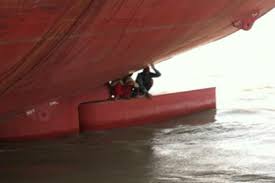8 min read
What is a stowaway? Whose responsibility are they?
By: Dryad Global on November 11, 2020 at 12:49 PM

The Convention on Facilitation of International Maritime Traffic, 1965, as amended, (The FAL Convention), defines a stowaway as "A person who is secreted on a ship, or in cargo which is subsequently loaded on the ship, without the consent of the shipowner or the Master or any other responsible person and who is detected on board the ship after it has departed from a port, or in the cargo while unloading it in the port of arrival, and is reported as a stowaway by the master to the appropriate authorities".
Stowaways are an ever-present problem for the shipping industry, in particular to those trading off the coast of West Africa, in Central America, Colombia, Venezuela and in the Dominican Republic.
Chart 1: Number of stowaways by nationality.
 Chart 1 shows the total number of stowaways by nationality for the policy years commencing 20 February 2007, 2011, 2014 and 2017 for those nationalities which have been amongst the ten countries with the highest number of stowaways in any of those four policy years.
Chart 1 shows the total number of stowaways by nationality for the policy years commencing 20 February 2007, 2011, 2014 and 2017 for those nationalities which have been amongst the ten countries with the highest number of stowaways in any of those four policy years.
In addition to vessels’ trade patterns, the problem of stowaways is closely linked to vessel, cargo type, and the level of security training and awareness of the crew.
What are the current global stowaway statistics?
Stowaway cases were increasing steadily prior to 2004. Following the introduction of the International Ship and Port Facility Security (ISPS) Code in 2004 there has been a drop in the number of reported stowaway cases. The trend, however, seems to be that the numbers are again on the increase.
Table 1: Summary data
|
|
2007 |
2011 |
2014 |
2017 |
|
Number of incidents |
842 |
774 |
503 |
432 |
|
Number of stowaways |
1,955 |
1,640 |
1,274 |
1,420 |
|
Total cost (US$ million) |
14.3 |
15.3 |
9.3 |
9.5 |
|
Cost/incident (US$ thousand) |
17.0 |
19.8 |
18.5 |
22.0 |
|
Cost/stowaway (US$ thousand) |
7.3 |
9.3 |
7.3 |
6.7 |
|
Stowaways/incident |
2.3 |
2.1 |
2.5 |
3.3 |
Table 1 presents the data on the number of incidents, the number of stowaways and the total cost of incidents net of deductible, and also calculates average data on cost per incident, cost per stowaway and the number of stowaways per incident.
Whilst the number of incidents nearly halved during the 11-year period from 2007 to 2017, the number of stowaways decreased by less than this because the number of stowaways per incident has increased by nearly 50%, from 2.3 per incident in the 2007 policy year to 3.3 per incident in 2017.
What vessels attract the most stowaways?
The majority of stowaways are found on board bulk, container and general cargo vessels. Car carriers are also over-represented in stowaway data compared to other vessel types.
How much can a stowaway cost to repatriate and who pays?
The costs involved in looking after and repatriating stowaways can be substantial. The repatriation of stowaways is difficult and generally involves moving reluctant people across several continents.
 In 2002 the average cost to ship insurers of each stowaway case was approximately USD 7,000. By 2008 this figure had increased significantly, to just over USD 18,000 (excluding the applicable deductibles paid by the Member). If more than one stowaway gains access to the vessel, the costs have been known to escalate to in excess of USD 100,000, because repatriation is usually only permitted with two security guards escorting each stowaway.
In 2002 the average cost to ship insurers of each stowaway case was approximately USD 7,000. By 2008 this figure had increased significantly, to just over USD 18,000 (excluding the applicable deductibles paid by the Member). If more than one stowaway gains access to the vessel, the costs have been known to escalate to in excess of USD 100,000, because repatriation is usually only permitted with two security guards escorting each stowaway.
In October 2020, during a transit of the English Channel, the Nave Andromeda found itself at the forefront of international news when seven stowaways on board began threatening crew. The vessel was stormed by British special forces who resolved the incident within 8 minutes, before handing the stowaways over to Hampshire Police. In the following days it emerged that a few days prior to the incident, European ports had refused to receive the stowaways. Attempts by the ship’s Greek captain to disembark the stowaways in the Canary Islands on October 15th and in Saint Nazaire on October 20th were both refused by the Spanish and French authorities.
So what is the stowaway guidance for a Ship’s Master?
Click here to read our in-depth guide on stowaways. It includes everything you need to know about best practice preventative measures, costs involved, stowaway information forms, the law and your legal obligations.
Related Posts
What threat does China pose within the South..
Dryad Global analysts James Welsh and Dorottya Zsiboracs on China's influence within the South..
Why is Iran focusing on its maritime capabilities?
Iran continually seeks to enhance its naval fleet and create an impression of considerable..
South China Sea: What could go wrong?
The Southeast Asian region is on tenterhooks anticipating how rapidly deteriorating US-China..




